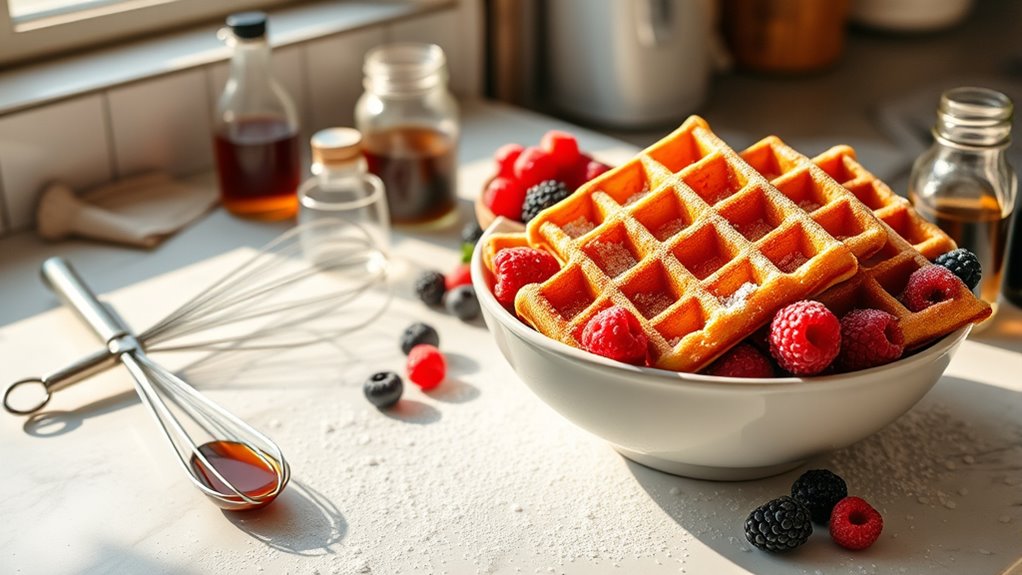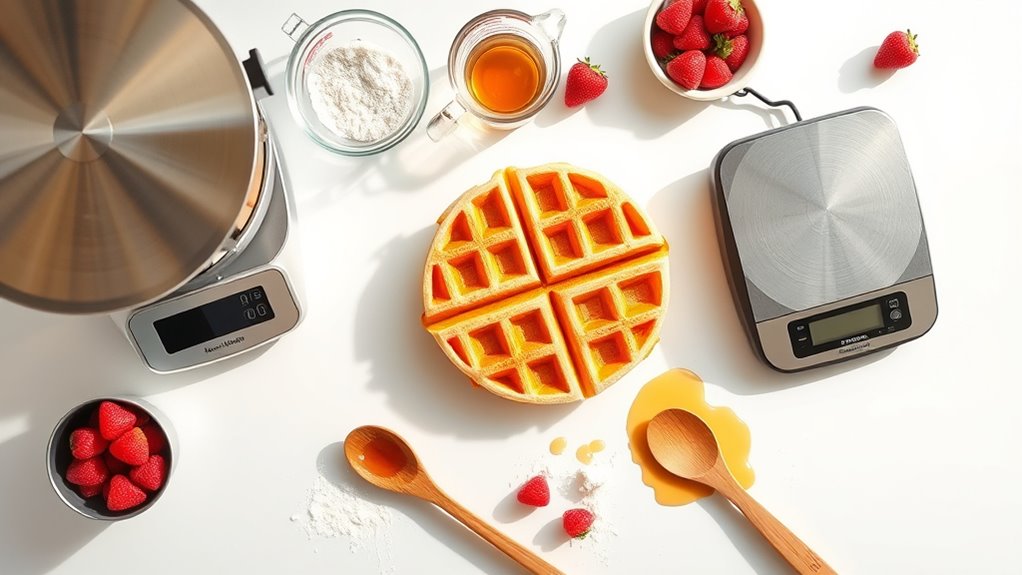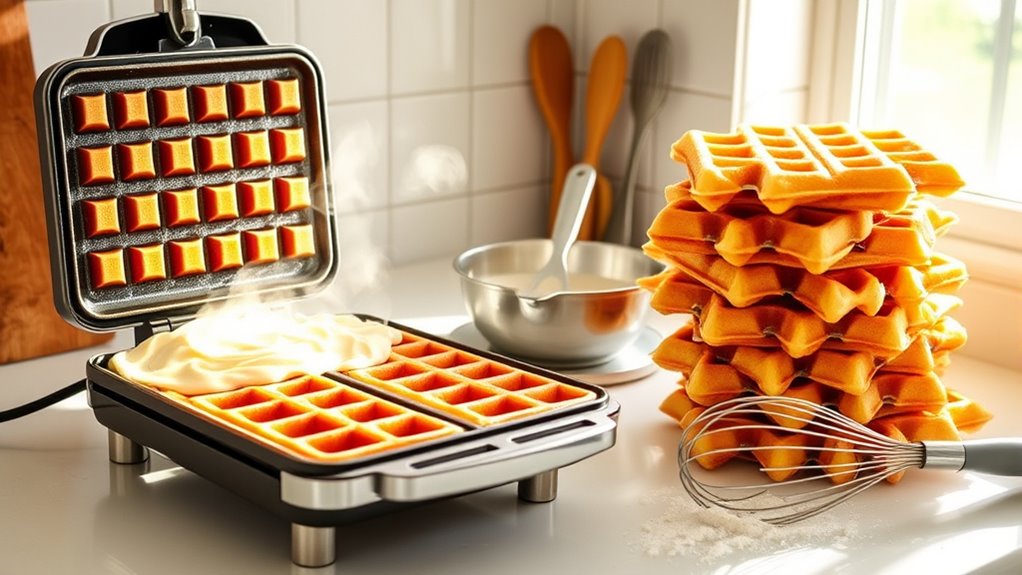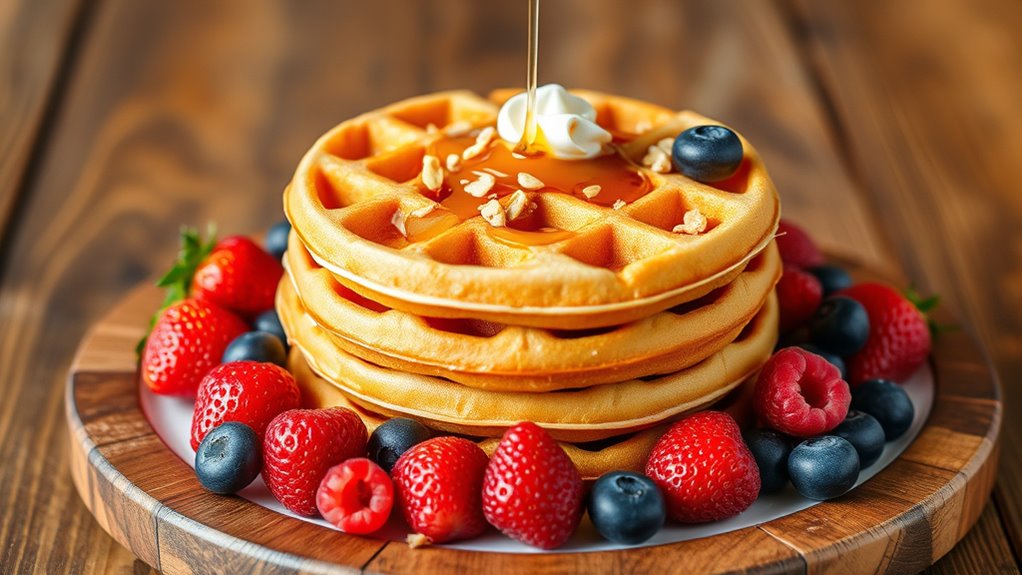To master yeast waffles in 7 easy steps, start by activating 2 ¼ tsp yeast in warm milk with sugar. Mix 2 cups flour, eggs, and milk until smooth but not overmixed. Let the batter rise for at least an hour until bubbly. Preheat and lightly grease your waffle iron, then cook batter for 4–6 minutes until golden and crisp. Serve with fresh toppings for flavor. Follow these steps, and you’ll discover tips to perfect your waffle game.
Ingredients and Quantity

To make the perfect yeast waffles, you’ll need five essential ingredients measured accurately: flour, yeast, sugar, milk, and eggs. Mastering these basics gives you the freedom to explore flavor variations and ingredient substitutions confidently.
| Ingredient | Quantity | Notes |
|---|---|---|
| Flour | 2 cups | All-purpose or bread flour |
| Yeast | 2 ¼ tsp (1 packet) | Active dry yeast preferred |
| Sugar | 2 tbsp | Adjust for sweetness variations |
| Milk | 1 ½ cups | Whole or plant-based alternatives |
| Eggs | 2 large | Room temperature for best rise |
Feel free to swap milk for almond or oat milk, and try honey instead of sugar to customize your waffles’ flavor profile.
Preparations

Before mixing your ingredients, make certain your yeast is properly activated by dissolving it in warm milk (about 110°F) with a pinch of sugar. This yeast activation step guarantees your waffles rise perfectly, giving them that light texture you want. Once your yeast bubbles, it’s time to combine your wet and dry ingredients carefully. Aim for a batter consistency that’s thick but pourable—too thin, and your waffles won’t hold shape; too thick, and they’ll be dense. Stir gently to incorporate air without overmixing, which can weaken gluten and affect rise. Let your batter rest in a warm spot for at least an hour to develop flavor and texture. These preparations set the foundation for waffles that are crisp outside, tender inside, and utterly satisfying.
Tools / Kitchenware Required

A reliable waffle iron is essential for achieving that perfect golden crust and fluffy interior in your yeast waffles. Alongside this, a few other kitchen essentials will streamline your process and enhance your results. Choosing a quality waffle maker with adjustable temperature settings lets you control browning and texture effortlessly. You’ll also need measuring cups, a mixing bowl, and a whisk to prepare your batter precisely. Here’s a quick overview of the tools you’ll want within reach:
| Tool | Purpose | Tip |
|---|---|---|
| Waffle Maker | Cook waffles evenly | Opt for non-stick surfaces |
| Mixing Bowl | Combine ingredients | Use a large size for ease |
| Measuring Cups | Accurate ingredient portions | Prefer clear markings |
| Whisk | Mix batter smoothly | Choose a sturdy, flexible whisk |
How to Cook

- Allow your yeast waffle batter to rise until bubbly.
- Preheat your waffle iron thoroughly to ensure even heat distribution.
- Lightly grease the waffle iron plates to prevent sticking while preserving the batter’s delicate texture.
- Pour the batter evenly onto the plates, avoiding overfilling to leave room for expansion.
- Close the lid gently.
- Cook the waffles until golden brown and crisp, typically 4–6 minutes depending on your appliance.
- Use a timer to achieve precise cooking results.
- Experiment with cooking techniques, such as adjusting heat levels or adding steam, to create different textures—from ultra-crispy to tender interiors.
- Maintain consistent temperature and timing to maximize the potential of your yeast waffles.
- Customize texture and flavor according to your preference.
How to Serve

Three key elements will elevate how you serve your yeast waffles: presentation, complementary toppings, and temperature. First, keep waffles warm by placing them on a wire rack in a low oven to maintain crispness. When plating, consider serving styles that reflect your mood—stacked for a hearty meal or separated for easy sharing. For topping suggestions, think beyond syrup: fresh berries, whipped cream, or a dollop of yogurt add freshness, while nuts or a drizzle of honey bring texture and sweetness. You can also experiment with savory options like smoked salmon or avocado for a bold twist. By focusing on these elements, you guarantee every bite is enjoyable and visually appealing, delivering a versatile waffle experience that matches your desire for freedom in flavor and style.
Tips
Serving your yeast waffles with the right toppings and presentation sets the stage, but mastering the process starts with a few key tips. First, choose your yeast types wisely; active dry yeast offers a reliable rise, while fresh yeast can add subtle flavor complexity. Always proof your yeast in warm water with a pinch of sugar to guarantee it’s active before mixing. When mixing batter, avoid over-kneading to keep waffles tender. Let the batter ferment for at least an hour to develop flavor and texture. For waffle toppings, balance sweetness with freshness—think fresh berries, a dollop of Greek yogurt, or a drizzle of honey. Finally, preheat your waffle iron thoroughly to guarantee even cooking and crisp edges. Following these tips assures a superior yeast waffle every time.
Food Value and Benefit
Yeast waffles provide a nutritious and tasty addition to your diet with several health benefits:
Yeast waffles are a delicious, nutritious choice packed with health benefits for your diet.
Food Value of Yeast Waffles:
- Made through fermentation, which breaks down carbohydrates for easier digestion.
- Contain B vitamins (such as B1, B2, B3, and B6) produced during fermentation, essential for energy metabolism.
- When prepared with whole grain flour, they are a good source of dietary fiber.
- Provide minerals such as iron, magnesium, and zinc, contributing to overall health.
- Have a moderate glycemic index compared to traditional waffles, promoting stable blood sugar levels.
Benefits of Eating Yeast Waffles:
- Improves digestive health due to fermentation and higher fiber content.
- Supports energy production and metabolism through B vitamins.
- Helps maintain stable blood sugar levels, reducing energy spikes and crashes.
- Contributes to mineral intake important for immune function, muscle health, and oxygen transport.
- Offers a balanced and satisfying option to complement a healthy diet.
Frequently Asked Questions
Can I Use Gluten-Free Flour for Yeast Waffles?
Yes, you can use gluten-free flour for yeast waffles, but you’ll want to choose gluten free alternatives that provide structure, like a blend of rice flour, tapioca starch, and xanthan gum. Keep in mind, gluten-free batter may need extra hydration and longer rising times. For baking tips, make sure your yeast is fresh and warm liquids activate it properly. Experiment with small batches to get your waffles light and fluffy without gluten.
How Long Can I Store Leftover Yeast Waffles?
You can stash your leftover yeast waffles in the fridge for up to 3 days before they start acting like ancient relics. For longer freedom, freeze them up to 2 months with airtight storage tips—wrap tightly or use a sealed bag. When you’re ready, toast or reheat for that fresh taste. Don’t forget to explore leftover recipes like waffle sandwiches or breakfast casseroles to keep your mornings exciting and waste-free!
Can I Freeze Yeast Waffle Batter for Later Use?
You can freeze yeast waffle batter, but yeast preservation can be tricky. Freezing batter slows yeast activity, so it might not rise as well after thawing. To freeze batter, place it in an airtight container and freeze quickly. When ready, thaw it slowly in the fridge overnight, then let it come to room temperature before cooking. Keep in mind, the texture and rise might be slightly different than fresh batter.
What Is the Best Yeast Type for Waffles?
Imagine your waffle batter as a garden, where yeast is the seed. For the best rise and freedom in flavor, choose active dry or instant yeast. Active dry yeast needs a warm bath to wake, giving you a slower, richer fermentation. Instant yeast, a sprightly sprite, jumps right into the mix for quicker results. Both liberate your batter beautifully, but instant yeast is your go-to for effortless, fluffy waffles every time.
Are Yeast Waffles Healthier Than Regular Waffles?
Yeast waffles can be healthier than regular waffles, thanks to their nutritional benefits. When you compare ingredients, yeast waffles often have a lower glycemic index because fermentation breaks down sugars, making them easier to digest. Plus, the fermentation process can increase certain nutrients, like B vitamins. However, your overall health depends on the full recipe, toppings, and portion size. So, choose ingredients wisely to enjoy both taste and freedom in your diet.
